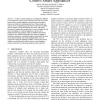Free Online Productivity Tools
i2Speak
i2Symbol
i2OCR
iTex2Img
iWeb2Print
iWeb2Shot
i2Type
iPdf2Split
iPdf2Merge
i2Bopomofo
i2Arabic
i2Style
i2Image
i2PDF
iLatex2Rtf
Sci2ools
ICDCSW
2003
IEEE
2003
IEEE
Studying the Use of Handhelds to Control Smart Appliances
Abstract— Today’s complex appliances are plagued by difficultto-use interfaces. In many cases, consumers use only a few of the many features on their appliances because the more complex features are hidden by confusing interfaces. This problem can only get worse as appliances get smarter, become more complex, and are subject to more demands by their users. This paper presents two studies that compare the accuracy and speed of real users controlling two common appliances, a stereo and a telephone/answering machine, using two different interaction techniques. Our studies found that people using an appliance interface presented on a handheld computer performed the same set of tasks in half the time while making half the errors as compared to using the appliance’s built-in control panel. These studies are motivating us to build a generic remote appliance control system that we call the personal universal controller.
Appliance | Appliance’s Built-in Control | Distributed And Parallel Computing | ICDCSW 2003 | Today’s Complex Appliances |
| Added | 04 Jul 2010 |
| Updated | 04 Jul 2010 |
| Type | Conference |
| Year | 2003 |
| Where | ICDCSW |
| Authors | Jeffrey Nichols, Brad A. Myers |
Comments (0)

